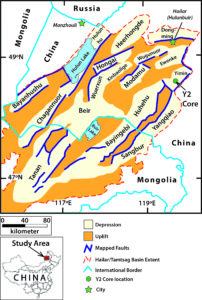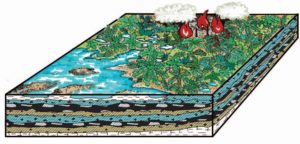Though mostly overlooked by sedimentologists and climatologists coal provides highly detailed information on past climates and tectonics.
In a recent paper* by myself and my colleagues (available Here) we take a look at a very thick (>40 m) coal of Early Cretaceous age in Inner Mongolia, near the borders with Russia and Mongolia.
Using stable carbon isotopes, organic composition, sedimentological relationships and previously published palynology and palaeogeography we concluded that palaeomires in the Hailar Basin formed over long periods of time (a P50 estimate places peat accumulation at about 280,000 years).
Fire was an important and constant part of the mire ecosystems, as indicated by the incredibly high content of fossil charcoal (‘inertinite’), which can be greater than 80% in some samples. This observation supports that the Early Cretaceous was a time of high levels of atmospheric oxygen.
Isotopic and organic composition data show that there were periods stable and unstable climate, each lasting about 100,000 years. Also, after nearly 200,000 years of peat maintaining accumulation equal to subsidence rates, the palaeomire was slowly drowned and terminated.
The utility of looking at palaeomires, such as the one in Hailar Basin, is that the climatic and tectonic influences will not be mire specific and can be inferred, in this case, to much of in-land Laurasia during the Early Cretaceous time.
In addition to the paper published in Cretaceous Research, a poster** is being presented at the 2020 Annual Conference of the Geosciences Society of New Zealand, University of Canterbury,Christchurch, New Zealand on the 24th of November (https://confer.eventsair.com/gsnz2020/ )
Previous blogs have also documented the early stages of this research (i.e.https://www.ciphercoal.com/something-wicked-this-way-comes-in-the-lower-cretaceous/, https://www.ciphercoal.com/not-freezing-in-inner-mongolia/, and https://www.ciphercoal.com/fire-and-brimstone-in-the-cretaceous/
* Moore, T.A., Moroeng, O.M., Shen, J., Esterle, J.S., Pausch, R.C., 2021. Using carbon isotopes and organic composition to decipher climate and tectonics in the Early Cretaceous: An Example from the Hailar Basin, Inner Mongolia, China. Cretaceous Research 118, 104674, https://doi.org/10.1016/j.cretres.2020.104674, 26 pp.
** Moore, T.A., Moroeng, O.M., Shen, J., Esterle, J.S., Pausch, R.C., 2020. Palaeomires as ciphers for climate and tectonics: an example from the Early Cretaceous Hailar Basin, Inner Mongolia, China, in: Bassett, K.N. (Ed.), New Zealand Geosciences Society Annual Conference. New Zealand Geosciences Society, Christchurch, New Zealand, Paper 119. https://confer.eventsair.com/gsnz2020/





Comments are closed.